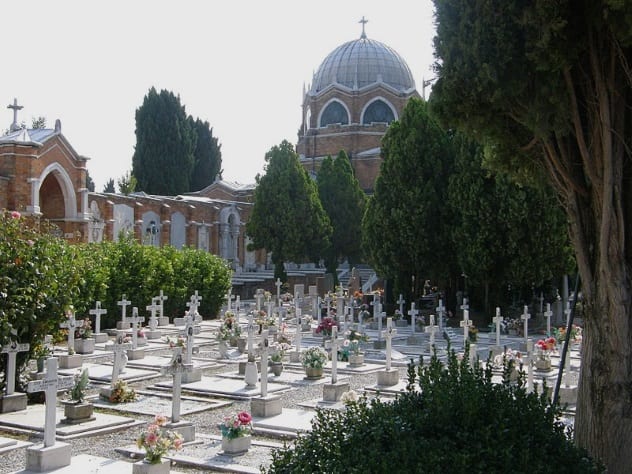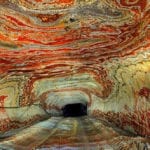 Politics
Politics  Politics
Politics  Weird Stuff
Weird Stuff 10 Freaky Times When Famous Body Parts Were Stolen
 Miscellaneous
Miscellaneous 10 Interesting Things Manufacturers Stopped Making and Why
 Gaming
Gaming 10 Funny Tutorials in Games
 History
History 10 Fascinating Little-Known Events in Mexican History
 Facts
Facts 10 Things You May Not Know about the Statue of Liberty
 Movies and TV
Movies and TV 10 Movie Adaptions That Brought Popular Songs to Life
 Health
Health 10 Miraculous Advances Toward Curing Incurable Diseases
 Miscellaneous
Miscellaneous 10 Undeniable Signs That People’s Views of Mushrooms Are Changing
 Animals
Animals 10 Strange Attempts to Smuggle Animals
 Politics
Politics 10 Countries Where Religion and Politics Are Inseparable
 Weird Stuff
Weird Stuff 10 Freaky Times When Famous Body Parts Were Stolen
 Miscellaneous
Miscellaneous 10 Interesting Things Manufacturers Stopped Making and Why
Who's Behind Listverse?

Jamie Frater
Head Editor
Jamie founded Listverse due to an insatiable desire to share fascinating, obscure, and bizarre facts. He has been a guest speaker on numerous national radio and television stations and is a five time published author.
More About Us Gaming
Gaming 10 Funny Tutorials in Games
 History
History 10 Fascinating Little-Known Events in Mexican History
 Facts
Facts 10 Things You May Not Know about the Statue of Liberty
 Movies and TV
Movies and TV 10 Movie Adaptions That Brought Popular Songs to Life
 Health
Health 10 Miraculous Advances Toward Curing Incurable Diseases
 Miscellaneous
Miscellaneous 10 Undeniable Signs That People’s Views of Mushrooms Are Changing
 Animals
Animals 10 Strange Attempts to Smuggle Animals
10 Strange Cemeteries You’ll Be Dying To Visit
Most people do not like to think too much about cemeteries. We tend to visit them only as often as we need to and then leave as quickly as is decently possible. This is a shame, because there are some cemeteries that are well worth closer inspection.
Though in modern times, we tend to be somewhat squeamish about the process of death and mortal decay, it has often been celebrated in ways that are endearing, interesting, or, sometimes, downright strange. Here, we look at a few of them.
10 Merry Cemetery

The Church of the Assumption in Sapanta, Northern Romania, serves a small town of only around 3,000 people. Life there is often hard, and the townspeople are mostly poor. Though they may not have much wealth in life, they are guaranteed a lavish and rather unique final resting place.
Since 1935, the buried dead have been interred in Merry Cemetery. Each grave is given a hand-carved headstone, colorfully decorated in, shall we say, a naive style and adorned with a bespoke poem that celebrates their life.
If your Romanian is good, you can wander around the cemetery reading the inscriptions, written in the first person from the dead person to you. Some poems are funny, such as Ioan Toaderu’s, which reads:
One more thing I loved very much,
To sit at a table in a bar
Next to someone else’s wife
And some are sad or even angry, like this one from a three-year-old girl, which is directed at the taxi driver who ran her over:
Burn in hell, you damn taxi
That came from Sibiu.
As large as Romania is
You couldn’t find another place to stop,
Only in front of my house to kill me?
If your Romanian is not so good, you might just enjoy looking at the colorful carvings which sometimes depict the manner of their subject’s dying in a disturbingly comic fashion.[1]
9 The Hanging Cemetery

For centuries, the people of the mountainous region of Sagada in the Philippines have chosen not so much to bury their dead as to hang them out to dry. The period from death to interment is a relatively long one. The deceased is first placed in a “death chair” inside their home, and the chair is positioned facing the front door so that they can “welcome” visitors. The corpse is covered with rattan leaves and smoked, which serves to preserve the body and also to help rid the home of that just-dead smell.
The corpse remains in the chair for several days before it begins the next stage of its final journey. Traditionally, it is placed in the fetal position, with legs tucked under the chin. Limbs will be broken to accomplish this if necessary, though in more recent times, fewer families are willing to do so. The body is then wrapped in fresh rattan leaves and a blanket and carried by mourners to the cemetery. There is often a large number of people willing to act as pallbearers, since it is considered lucky if any of the bodily fluids leak through the leaves and drip on the mourners.[2]
Once at the cliffside cemetery, the body is fitted inside a coffin, usually only 1 meter (3.3 ft) wide. The coffin is then nailed to the side of the cliff. The higher the coffin is placed, the greater the person’s position in the tribe was in life. It is believed that the elevated coffins will bring them closer to their ancestral spirits.
The privilege of a hanging coffin is not open to everyone. It is reserved mostly for tribe elders, as it is believed that the corpses of those who died young are considered bad luck.
8 The Underwater Cemetery

An interment at the Neptune Memorial Reef gives a whole new meaning to the saying, “He sleeps with the fishes.”
Found about 5 kilometers (3 mi) off the coast of Florida, the Neptune Memorial Reef has been artificially created in around 12 meters (40 ft) of water. It has several classical-style statues to give it an Atlantis feel and would be a paradise for scuba divers. However, not only has the reef been built to encourage marine life, but it has also been specifically made to hold the cremated remains of those who want to be buried at sea.[3]
It is hoped that the remains will help to feed the coral and expand the reef. Although the burial of uncremated remains would be more nutrient-rich, they are currently not permitted.
7 Cross Bones

The Southwark area of London, where Shakespeare’s Globe Theatre once stood, was always a rather seedy place. There were a large number of taverns and a large amount of prostitution. During the 12th century, the bishop of Winchester had the right to license and tax prostitutes, who were known as the “Winchester Geese” because of their habit of exposing their white breasts to passersby. The phrase “bitten by a Winchester Goose” meant “contracted a sexually transmitted disease.”
The brothels, known as “stews,” thrived despite periodic attempts to close them down, so they were brought under the control of the Church, and regulations were drawn up requiring that prostitutes be registered, did not work on religious holidays, and did not sleep with anyone for free (presumably so that no one would feel hard done by).[4]
Although the bishop was content to tax the working girls, he was not prepared to bury them in holy soil. A plot of unconsecrated land, officially called the Single Woman’s Churchyard but unofficially known as the Cross Bones Cemetery, was set aside for their remains.
In the 17th century, Cross Bones became a graveyard for paupers and those without the means to pay for their burial. As a final indignity, their corpses were often stolen by body snatchers.
In 1992, the Museum of London carried out an excavation at Cross Bones. They found bodies crammed in on top of each other and, most surprisingly, discovered that over half of the bodies were from those aged under five years old at the time of their deaths.
6 Napoleon’s Cemetery

The island of San Michele stands in the Venetian Lagoon, and its cemetery is hidden by high walls, although it is open to visitors. The island was inhabited by monks from the 15th century until comparatively recently. Their monastery boasts a domed roof and a magnificent statue of an angel over the entrance.
When Napoleon invaded Venice, he decreed that, because of Venice’s tendency toward flooding, it was unhygienic to bury the dead on the main island. (You can see his point.) San Michele was designated as the official Venetian cemetery, and it is still in use today. The island offers fabulous views in a prestigious location, sitting as it does between Venice and Murano.
The dead may have expected to be able to rest in peace there, but since 1995, overcrowding at San Michele has meant that “inhabitants” can only be granted a ten- or 20-year lease, after which their remains are evicted to make way for new tenants.[5]
5 The Cemetery Of 200,000 (And 1)

Okunoin Cemetery in Japan contains almost a quarter of a million graves but is the focus of only one. It is the final resting place of Kobo Daishi, the founder of Shingon Buddhism and one of the most important people in Japanese religious history. He is said to be resting in eternal meditation while he awaits the coming of the Buddha of the Future.[6]
While he waits, Kobo Daishi is said to provide help to those pilgrims who ask for it. Visitors must bow before crossing a bridge into the cemetery, which contains 200,000 tombstones, all of which are set out to line the way to his mausoleum. Many prominent people and religious monks chose to be buried here in the hope that being close to his remains will bring them closer to salvation when the Buddha of the Future arrives.
In front of the mausoleum itself is the Hall of Lamps, which contains 10,000 lanterns, which are always lit, and 50,000 tiny statues, all of the great man. Visitors are able to leave Kobo Daishi offerings in the aptly named Offering Hall, though, word to the wise, he is probably okay for a while when it comes lamps and statues.
4 Dracula’s Cemetery

St Mary’s Church at Whitby was built in 1110, and its churchyard dates from around the same time.
The graveyard must have always held a certain amount of Gothic fascination, because it was the inspiration for a scene in Bram Stoker’s Dracula. In the novel, the vampire lands at Whitby and leaps from his ship (whose crew is mysteriously dead) and hides himself in an abandoned crypt in a church that very much resembles St Mary’s. Stoker stayed in the town while writing his novel, and he was said to have been very much taken with the atmospheric surroundings.[7]
Current visitors may find more gore than they were hoping for, however. The pounding of the sea has caused erosion along the cliffs, and subsequent landslides have exposed a number of corpses, though none so far have been sporting elongated teeth and a theatrical dress sense. Work is ongoing to try to prevent the churchyard, and its contents, from slipping into the sea.
3 The Cemetery Of Shame

The Oise-Aisne American Cemetery in France is a military burial ground dedicated to those killed in action during World War I. There are 6,012 soldiers whose graves are proudly marked in four plots, marked A to D.
However, there is another plot at the cemetery, separate from the others. Plot E can only be accessed through the office of the superintendent. This plot contains 96 unmarked graves belonging to American soldiers who were dishonorably discharged and executed for crimes committed during World War II. None of these graves are mentioned by the American Battle Monuments Commission’s website for Oise-Aisne.
Between them, these men are alleged to have murdered 26 American soldiers. They are also alleged to have raped and/or murdered 71 civilians of other nationalities. The plot was designated as a place of burial for the “dishonorable dead.” The graves are identified only by number, and the dead are set with their backs to the rest of the fallen. The American flag is not permitted to fly over Plot E.[8]
The only inhabitant of the plot not convicted of rape or murder was Private Eddie Slovik, who was executed for desertion on January 31, 1945, the only man to be executed for this crime since the Civil War. His remains were removed in 1987, and he was reburied next to his wife after his family petitioned President Reagan for a pardon.
2 The Cemetery Of A Million Mummies

In an Egyptian cemetery whose name means, for reasons unknown, “The Way of the Water Buffalo,” archaeologists have discovered a million mummies. Literally.
The burial ground dates from the first to the seventh centuries, and most of its dead were buried without coffins or grave goods of any kind, so those hoping for a Tutankhamen-style treasure trove are likely to be disappointed. The cemetery was used by poor, low-status citizens of Egypt while it was controlled by the Roman Empire.
Although they couldn’t afford the lavish funeral rituals of the pharaohs, great care was taken by mourners in the burying of the dead. Scientists have yet to discover the reason for the incredibly large number of bodies, since it is unlikely that they were all local inhabitants.[9]
The archaeological dig has uncovered some surprising specimens, including one mummy that was over 213 centimeters (7′) tall and had to be bent in half to fit inside the grave as well as a number of blond and redheaded mummies. It may be that the cemetery authority buried people according to hair color, as clusters of redheaded and blond mummies have been discovered throughout the site. Then again, of course, they may have just buried families together.
1 The Plague Cemetery

In 1665, a tailor in the small parish of Eyam ordered a bale of cloth from London. When it arrived, the cloth seemed somewhat damp, so he put it in front of the fire to dry. Unfortunately for the inhabitants of Eyam, the cloth contained a number of fleas. And even more unfortunately, the fleas were carrying bubonic plague.
Within two months, the tailor was dead, along with 42 other souls. The church rector, believing that he had a duty to prevent the disease from spreading to neighboring villages, decided that the entire village should quarantine itself. He told his parishioners that if they agreed to stay, he would remain with them and do everything in his power to relieve their suffering.
Knowing that he may well have been signing all their death warrants, he set up a “cordon sanitaire” around the village. Almost no one tried to escape, even as the death toll mounted. Some people lost almost their entire families to the disease. A woman named Elizabeth Hancock buried her husband and six children in only eight days. She had to dig the graves herself, since none of the villagers wanted to go near her.
The task of burying the dead was a dangerous one. Marshall Howe, who had been infected early on but survived, volunteered for the task, believing that he was now immune. He often helped himself to the deceased’s possessions by way of payment, and it is believed that his wife and two-year-old son probably caught the disease from the stolen items. They were not as lucky as Mr. Howe, and he soon had the job of interring them, too.
The graves of the plague victims can still be seen in Eyam Parish Churchyard. Marshall Howe survived the plague, as did the church rector, though the rector’s wife succumbed after prolonged contact due to nursing the dying. By November 1666, with half the village dead, the plague was eradicated, and the neighboring villages were saved.[10]
Ward Hazell is a writer who travels, and an occasional travel writer.
Read about more interesting cemeteries around the world on 10 Fascinating Graveyards You Must See and 10 Intriguing Historical Graveyard Finds.








